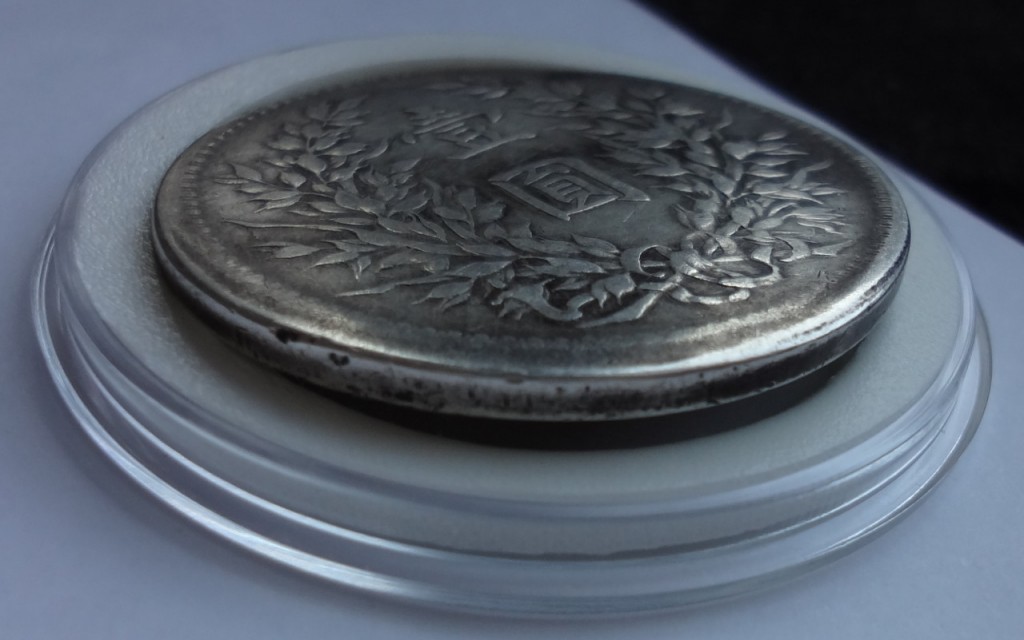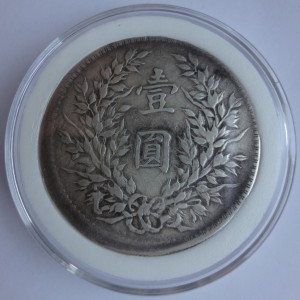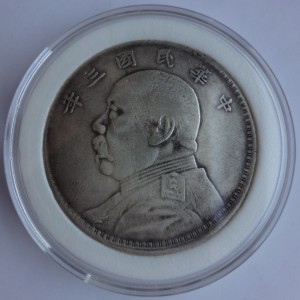The plain edge of this “Fatman dollar” is not the result of circulation wear. Despite being called 光边 in Chinese, literally “bald edge”, it has not been shaved either. The usual reeding was simply never fully impressed onto the coin blank. If you look carefully indeed, you will notice a thin reeded part up to 6 o’clock. This Yuan Shih Kai dollar has actually suffered a random minting error called “broadstrike“.
Modern coins are machine struck. A blank is automatically placed above the lower die (or anvil die), fixed to the bed of the machine. The collar die is then brought up so as to encircle the blank, as the upper die (hammer die) is brought down with tremendous pressure. This cause the soft metal to flow like a viscous solid: prevented from escaping on the sides by the collar, it effectively gets imprinted by filling the engraving of the dies. If the collar was crenated, the edge of the coin will thus be reeded. This mechanical process was repeated about one hundred times per minute by the coining presses available at the time, and failures would inevitably happen sometimes. Broadstrike is caused by a particular problem: the collar die which is supposed to raise and surround the blank may get stuck due to some accumulation of debris or grease. If that happens, the metal unconstrained by the collar expands and increases in diameter during the strike. This results in a coin with all its design elements present, but an expanded shape: a broadstrike.
In the case of this “Fatman dollar“, we can deduce from the very thin reeding that the collar was partially engaged. The side with no reeding, completely unrestrained by the collar die, expanded the most. This type of coins is referred to as uncentered broadstrikes. This kind of error provides informations about the minting process. The traces left by the collar being on the reverse part of the edge means that the Yuan Shi Kai portrait was engraved on the hammer die.
Such misshapen coins are the result of random errors, but are accounted for by the mint. They are systematically destroyed when found during counting and packing the coins for dispatch. Very few of these coins indeed manage to slip through the combined vigilance of counting machines and human assayers to end up circulating. Even then, due to their suspicious appearance, they often are the first to get melted down for their precious metal content. It is therefore very rare for these unloved coins to reach the hand of a caring collector!



how much is the coin worth now?
This kind of error coins has a highly variable price, since not so many collectors are interested in them. The lowest price I have seen was ¥5000 CNY (about $800 USD) and the highest ¥9000 CNY (~ $1,400 USD).
Hi. I came across your website, and wanted to thank you for your professionalism and awesome knoweldge of Chinese coins. I know they are hot right now, very collectible, but also there is not much known and tons of replicas.
So my late Grandfather left me many coins. I have a fatman dollar, with six symbols above the fatman. My question is this?
I would like to send to NGC to get graded, and I know there are like 5 variety’s they recognize. Most of those have to do with the edge, as in reeded, or the T’s, etc. But they (NGC) claims there is a variety that is Y#322.1, a restrike made in 1918 for collectors?
The value is considerable for what is a sometime oft common coin.
I have attached some photo’s, can you tell me about my coin?
Thanks! and best regards,
Joshua.
http://i1232.photobucket.com/albums/ff368/joshuamiles/Fatman/P1090082.jpg
http://i1232.photobucket.com/albums/ff368/joshuamiles/Fatman/P1090083.jpg
Hello, sorry for the late reply! Your coin is indeed a 1914 Yuan Shih Kai dollar. It is in pretty decent shape, but it is not a variety. The 1918 restrike is a rare proof coin, and from the pictures you have linked here your YSK dollar is a business strike. It should receive a good grade, even if I am concerned about what seems to be hairlines on the obverse. You may likely get it slabbed as AU-50 or AU Details: hairlines.
Hi, just wondering if you could help me. I have a similar but both sides of the coin have the observe (the man’s side pose). I found that coin in a junk yard and I am not sure whether it’s a minting error or just a replica. There is not chinese letterings or characters on the back apart from what’s showing on the observe. Also the heads on both sides are not medal-turn or both up, if one is 90 degree the other one on the back will be 45 degree approximately.
Can you please help me solving the mystery of this coin?
Many thanks
Here is the photo of the coin.
Thanks
http://i.ebayimg.com/00/s/NTMzWDgwMA==/$T2eC16FHJGYFFlIqpy1wBR0rf6fcgg~~48_80.JPG
Hello, unfortunately as users of the China-Mint.info forum confirmed, this is a fake coin.
Hello and thank you for your wonderful website. I would be grateful if you could tell me the year of my coin and whether you think it is genuine. It came from my father who would have collected it in the 1950′s. Many thanks.
http://imagehost.vendio.com/a/892459/view/Chinafro.jpg
http://imagehost.vendio.com/a/892459/view/Chinarev.jpg
Hello Chris, this is a genuine 1919 Yuan Shih Kai dollar.
Hi
I have three china “fat an dollars” but they have the face on both sides of the coin. Do you know why this happened?
Hello, this kind of mistake appears somewhat frequently on fake coins. I suspect that if you weigh these three coins, you will find them to be lighter than 26.8 grams.
Hello,
Great informative website!
After hours of searching for info on the 1914 “Fatman Dollar” with the T edge, I came cross your site, since you have a knowledge on these would you mind taking a look at the attached link to photos of mu “Fatman Dollar”.
There is also pictures of a 1916 dragon dollar with a plain edge, if you know anything of this it would be appreciated…
Thank you for your time.